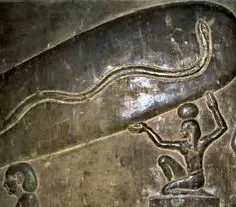Some people claim that lighting in ancient Egypt was provided using the classic bulbs we employ today. The Egyptian pictures show bulb-like devices with filament wires, a holder, and current wires. The lamps had filaments permitting electric current to flow inside it.
The cathode-ray tube or “Crookes’ tube” like object depicted in the pictures of a temple of Hathor at Dendera may depict a relativistic source of the heavy electrons – which could drastically expedite the magical processes which involve these particular tubes.
Dendera Egyptian Light Bulb

In this temple in Dendera, several dozens of kilometers north of Luxor, some experts found the light. The walls are decorated with human figures next to bulb-like objects reminiscent of oversized light bulbs. Inside these “bulbs,” there are snakes in wavy lines. The snakes’ pointed tails issue from a lotus flower, which, without much imagination, can be interpreted as the socket of the bulb.
Something similar to a wire leads to a small box on which the air god is kneeling. Adjacent to it stands a two-armed djed pillar as a symbol of power, which is connected to the snake. Also remarkable is the baboon-like demon holding two knives in his hands, which are interpreted as a protective and defensive power.
One piece of evidence that Ancient Egyptians may have used electricity is the absence of any traces of soot on the interior walls of their tombs and pyramids. If-as evolutionist archaeologists maintain-they used burning torches and oil lamps for lighting, then traces of soot would inevitably have been left behind.
In the picture discovered on a tomb wall in the Dendera Temple, an electric cable is leading away from a lamp with three bulbs. Also, there were pictures discovered on a tomb wall in the Dendera Temple, an electric cable is leading away from a lamp with three bulbs. The ancient Egyptians also had a Direct Current (DC) battery.
Erich Von Daniken is one of those researchers bringing revelations such as the Ancient Egyptian Light bulb into the light challenging the orthodox belief that Thomas Edison invented the Egyptian Light Bulb and Direct Current. Although there are some claims which do not support this belief.
Von Daniken claimed in Eyes of the Sphinx (1996) that the Dendera light bulb is located in a small, secret chamber that “can be accessed only through a small opening. The room has a low ceiling. The air is stale and laced with the smell of dried urine from the guards who occasionally use it as a urinal.” However, contrary to his claims, the room is open to the public and is frequently visited by tourists.
